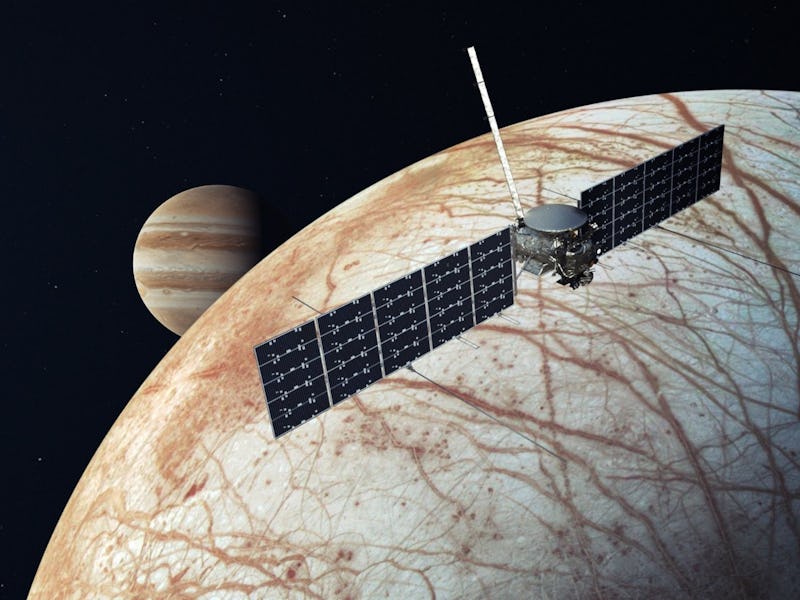Jupiter's Icy Moon Europa May Be Missing a Key Ingredient for Life
A recent study suggests the icy moon's hidden ocean may be anoxic.

Jupiter’s moon Europa has several key ingredients for life, but it may be short on one: oxygen.
A new study out today in the journal Nature Astronomy used data from NASA’s Juno spacecraft to simulate how much oxygen could be circulating in Europa’s oceans. It turns out, it is a lot less than researchers previously thought. Researchers formerly thought that there was likely quite a bit of oxygen on Europa, and therefore a good chance of life there, too.

This illustration show’s what NASA’s Europa Clipper spacecraft may look like as it orbits Europa in the 2030s.
Anoxic Alien Seas
To figure out how much oxygen might be getting into Europa’s oceans, Jamey R. Szalay, a planetary scientist at Princeton University and lead author on the study, and his colleagues examined data from Juno’s Jovian Auroral Distribution Experiment (JADE), which measures the ions (electrically charged atoms) left in Europa’s wake as it orbits Jupiter. JADE captured the data during Juno’s close flyby of Europa in September 2022.
Specifically, the team measured the amount of ionized oxygen and hydrogen JADE detected in Europa’s wake and used a computer simulation to figure out how much total oxygen had to be released at Europa’s surface every second to produce the amount of ions JADE measured in space 200 miles from the moon’s surface.
The answer turned out to be a measly 12 kilograms per second. That’s a lot less than previous models had predicted. Only about a fraction of that amount makes its way into the ocean below. This means that there is hardly any oxygen in Europa’s oceans.
“Unless Europa’s oxygen production was significantly higher in the past, the oxygen production rates found here […] provide a narrower ranger range to support habitability than previous model-driven estimates,” write Szalay and his colleagues.
Breaking bonds
How do ions at Europa’s surface make their way into the ocean? On Europa’s surface, radiation and electrically charged particles, like electrons, constantly bombard the surface of the ice. That radiation breaks the bonds that hold water molecules together, releasing oxygen and hydrogen molecules from their frozen prison.
Some of those molecules escape into space and collide with other molecules or get zapped by yet more radiation and become the ions that JADE studies. Others become part of Europa’s thin wisp of an atmosphere. Still others settle back into the ice; they’re trapped in a crystalline matrix of frozen water, but this time they’re imprisoned oxygen molecules, not just pieces of water molecules.
Ice, and things trapped in it, are in constant motion, even if that motion is very slow. Over time, some of that trapped oxygen gets shifted slowly downward through Europa’s kilometers-thick layers of ice, where it “may work into the ocean as a possible source of metabolic energy for life,” write Szalay and his colleagues in their recent paper.
We’ll get a much more direct look at how much oxygen is in Europa’s oceans, or whether there’s alien life swimming around down there in the cold dark, when NASA’s Europa Clipper arrives in 2030.